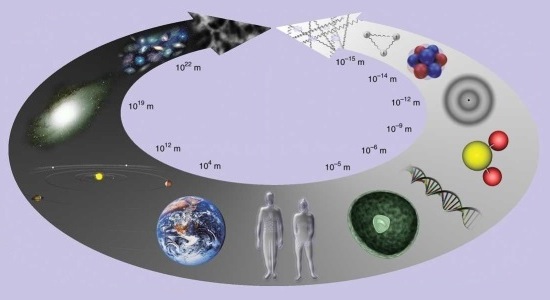
Why is carbon more abundant than gold in the universe, and where do these substances come from? This question will hopefully be answered by the end of this section concerning the building blocks that make up the entire universe. Understanding these basic units allows us to manipulate their properties to advance our technologies and cater them to our ever-changing needs. Everything, from the smallest computer chip in your iPod to you to the largest galaxies in the universe, is comprised of what we now call atoms. The study of atoms and their behaviours has led to some very interesting and useful discoveries, without which there would not be an iPod at all. Peruse this section and learn about the basic constituents of that tree you can see from your window, as well as yourself!
If you were asked to imagine an apple, including how it behaves, what it looks like and its size compared to other objects you would have very few problems. This is mostly because, although we don’t really realise it, an apple is of the same order of magnitude as the world we regularly interact with. It’s also easy, for instance, to visualise a computer or another human being. Trying to imagine a single grain of sand or the sheer scale of mountains compared to ourselves is far trickier. This is the reason why our imaginations have such a difficult time comprehending the scale of the universe, for example, or the size of an atom.

| Name | The Number | Prefix | Symbol | trillion | 1,000,000,000,000 | tera | T | billion | 1,000,000,000 | giga | G | million | 1,000,000 | mega | M | thousand | 1,000 | kilo | k | hundred | 100 | hecto | h | ten | 10 | deka | da |
| unit | 1 | tenth | 0.1 | deci | d | hundredth | 0.01 | centi | c | thousandth | 0.001 | milli | m | millionth | 0.000 001 | micro | µ | billionth | 0.000 000 001 | nano | n | trillionth | 0.000 000 000 001 | pico | p |
You may think that on such different scales there cannot be a connection between atoms and galaxies. However, scientists have fairly recently realised that you cannot fully understand the processes within a galaxy without understanding what it’s made of at the most basic level of atoms and smaller. Nuclear physics in particular spans the great divide of the scales, as you will see in a later chapter concerning stars and the critically important process of stellar nucleosynthesis.
We will now go on to look at the matter that makes up everything we see in more detail
>